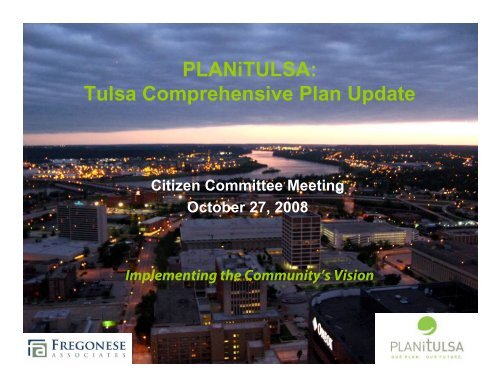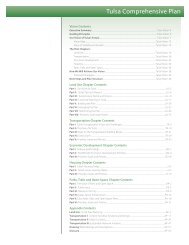View as PDF - PLANiTULSA
View as PDF - PLANiTULSA
View as PDF - PLANiTULSA
You also want an ePaper? Increase the reach of your titles
YUMPU automatically turns print PDFs into web optimized ePapers that Google loves.
<strong>PLANiTULSA</strong>:<br />
Tulsa Comprehensive Plan Update<br />
Citizen Committee Meeting<br />
October 27, 2008<br />
Implementing the Community’s Vision
Project management/ schedule update<br />
Workshop update & understanding the workshop results<br />
Small area workshop nominations<br />
•Process<br />
• Schedule<br />
• Promotion<br />
• Discussion<br />
Guiding Principle work session<br />
• Review potential Guiding Principles<br />
• Discuss, add and amend<br />
• Prioritization work session by committee members<br />
• Review and summarize priorities<br />
• Committee feedback/discussion<br />
Questions/discussion<br />
AGENDA
Workshop Update<br />
Citywide Workshops:<br />
• September 22 & 23 2008<br />
Overflow Citywide Workshop:<br />
• October 28, 2008
Workshop Update<br />
Understanding the<br />
Workshop Results
Workshop Results
Highest Occurrence of all Chips
More than one Chip placed<br />
(Highest Occurrence)
Workshop Update<br />
Small area workshops December 9:<br />
• North Tulsa<br />
• E<strong>as</strong>t Tulsa<br />
Requesting nominations for additional<br />
small area workshops:<br />
• Three small area workshops week of January 27<br />
• Two small area workshops week of February 24<br />
• Transportation workshop week of February 24
N. Peoria<br />
E. Virgin St.<br />
I 75
E. 21st St.
Small Area Nominations<br />
Seeking 5 are<strong>as</strong> that:<br />
• Illustrate local planning issues typical in other are<strong>as</strong><br />
• Illustrate a variety of conditions such <strong>as</strong>:<br />
New commercial are<strong>as</strong><br />
Neighborhood stabilization<br />
Transportation-land use issues<br />
Redevelopment opportunities<br />
Mixed use development types and patterns<br />
Walkable neighborhoods<br />
Affordable housing opportunities<br />
Housing mix of density, style and price<br />
Redevelopment of vacant strip centers<br />
Infr<strong>as</strong>tructure needs<br />
Improved transportation and connectivity<br />
Main Streets
Small Area Nominations<br />
Nominations due November 10, 2008:<br />
1. Description of site<br />
2. Land use, transportation, or development-related<br />
planning issues.<br />
3. Previous plans and planning activity<br />
4. Local support<br />
5. Organizations willing to help promote the workshop
Small Area Nominations<br />
Selections will take into consideration:<br />
• Geographic distribution<br />
• Economic and demographic characteristics<br />
• Consideration of a wide range of planning issues<br />
• Selected sites should display a diverse range of situations and<br />
challenges<br />
Review submittals and recommended are<strong>as</strong> with committee on<br />
December 8
Guiding Principles<br />
Answer the question: “What should Tulsa be in<br />
the future?”<br />
• Used in evaluating development scenarios<br />
• Guide the development of plan recommendations - the<br />
goals, policies, and strategies of our Plan<br />
• Ensure that the planning and implementation process<br />
moves forward in a predictable manner and that our Plan<br />
remains consistent with the shared vision of Tulsa’s citizens
Guiding Principles<br />
Evaluating Development Scenarios<br />
Example Guiding Principle: "Cluster new development<br />
in are<strong>as</strong> already developed and served by infr<strong>as</strong>tructure.”<br />
Me<strong>as</strong>urement: Amount of acreage used for new<br />
development<br />
Acreage<br />
used for new<br />
development<br />
120,000<br />
100,000<br />
80,000<br />
60,000<br />
40,000<br />
20,000<br />
111,246<br />
95,014<br />
63,964<br />
0<br />
Scenario<br />
A B C
Guiding Principles<br />
Guide Plan Development<br />
Guiding Principle - Embrace and retain the rural and historic character of the parish.<br />
Focus on attracting new housing and jobs to existing developed are<strong>as</strong> already served by<br />
infr<strong>as</strong>tructure.<br />
Goal: Maintain the parish’s rural character and environmental <strong>as</strong>sets;<br />
accommodate future growth in a sustainable and equitable development<br />
pattern<br />
Policy: Guide the majority of projected residential and employment<br />
development to are<strong>as</strong> served by urban water and sewer infr<strong>as</strong>tructure in<br />
the southern part of the parish<br />
Action: Plan and develop services and urban infr<strong>as</strong>tructure,<br />
including water and sewer facilities, to accommodate 80 percent of<br />
the projected future growth within the parish.
1. Create and retain good quality jobs for people of all<br />
ages, with a focus on our youth<br />
2. Attract companies that bring a wide range of job<br />
opportunities to Tulsa’s residents<br />
3. Create an environment that supports new and<br />
expanding entrepreneurs and small business owners<br />
4. Restore Downtown’s vitality and enable it to regain its<br />
role <strong>as</strong> the region’s economic engine<br />
http://farm1.static.flickr.com/107/315072192_27861ff3e4.jpg?v=0<br />
5. Attract people and businesses by developing vibrant<br />
urban centers<br />
Economy<br />
6. Provide adequate infr<strong>as</strong>tructure in underserved parts of<br />
the city to encourage future growth
7. Promote new business growth in all are<strong>as</strong> of town<br />
8. Recognize quality of life, natural beauty, diversity and<br />
the uniqueness of the city <strong>as</strong> important<br />
9. Cooperate with regional economic development efforts<br />
to strengthen the region’s ability to compete effectively<br />
in the global economy<br />
10.Support an educational system that results in an<br />
educated workforce in all segments of the community<br />
and includes training for a wide range of job skills<br />
http://farm1.static.flickr.com/107/315072192_27861ff3e4.jpg?v=0<br />
11.Foster cooperation among civic, business, and<br />
government stakeholders for continued economic<br />
success; avoid competition between entities<br />
Economy
Equity and Opportunity<br />
1. Eliminate the disparity in life expectancy between North Tulsa and South<br />
Tulsa by addressing public health issues<br />
2. Lead the nation in health improvement, dise<strong>as</strong>e prevention and dise<strong>as</strong>e<br />
management efforts<br />
3. Have an excellent K-12 school system that makes people want to live in<br />
Tulsa<br />
4. Provide choices in the type of school systems available<br />
5. Reduce dropout rates<br />
6. Expand the opportunity for small, medium-sized and minority businesses<br />
7. Involve youth and high school age children in planning for their future<br />
8. Ensure all residents have access to quality housing, jobs, education and<br />
health care
Equity and Opportunity<br />
9. Commit Tulsa to be inclusive, have a variety of income levels, and be<br />
accessible to all races, cultures, and ethnicities<br />
10. Respect the cultural and political identity of Native Americans<br />
11. Respect the historic accomplishments <strong>as</strong> well <strong>as</strong> historic challenges<br />
of all races<br />
12. Strive for greater community engagement in government and other<br />
civic activities<br />
13. Ensure that intolerance and prejudice, explicit or covert, is not used<br />
in the formation of land use and other public policy<br />
14. Make development information, regulations, and processes<br />
accessible and available on the internet and other information<br />
channels<br />
15. Build trust in government; make government functions transparent,<br />
accessible, and participatory
1. Implement development patterns that restore, protect and conserve<br />
environmental resources<br />
2. Make Tulsa more sustainable by moving toward carbon neutrality,<br />
reducing water consumption, reducing energy consumption and<br />
decre<strong>as</strong>ing vehicle miles travelled and/or using more efficient<br />
transportation<br />
3. Promote development that contributes to cleaner air and water and<br />
preservation of natural resources<br />
4. Support and provide incentives for sustainable design and development<br />
5. Consider open space <strong>as</strong> essential infr<strong>as</strong>tructure on par with sewer, water<br />
and roadways<br />
6. Ensure that parks and open spaces are e<strong>as</strong>ily accessible to residents in<br />
every neighborhood in the city<br />
7. Maintain existing parks, pools and trails<br />
Environment
1. Provide affordable housing of different types and styles for people of all<br />
ages<br />
2. Create and maintain safe neighborhoods<br />
3. Encourage a variety of housing options – in location, style and size<br />
4. Protect historic neighborhoods and require compatible new development<br />
within these are<strong>as</strong><br />
5. Encourage new homes and jobs throughout the city<br />
Community & Housing<br />
6. Provide quality housing and schools for people working in the city<br />
7. Make Tulsa known nationally for its many <strong>as</strong>sets - the fine arts, art deco<br />
architecture, the river, music, and our rich ethnic heritage<br />
8. Provide accessible cultural, entertainment and public gathering spaces<br />
9. Provide all Tulsans, young and old, with compelling re<strong>as</strong>ons to remain in<br />
Tulsa; make Tulsa a destination city for all
Community & Housing<br />
9. Create an alternative to (not a replacement for) suburban living: places<br />
that offer high density urban environment with round-the-clock activity<br />
and support of alternative lifestyles<br />
10. Make Tulsa's heart - downtown - healthy and vibrant<br />
11. Incre<strong>as</strong>e density for sustainability, livability, walkability and costefficiency<br />
12. Develop land use regulations that enhance and protect community<br />
livability<br />
13. Extend opportunities to shop for b<strong>as</strong>ic needs in under-served are<strong>as</strong> of<br />
the city<br />
14. Focus community investment in targeted are<strong>as</strong> of the city, i.e. North<br />
Tulsa<br />
15. Enhance the quality of life in Tulsa to retain and attract young people<br />
to move to Tulsa
1. Provide affordable housing of different types and styles for people of all<br />
ages<br />
2. Create a seamless transportation system that includes multiple modes of<br />
transportation across the city<br />
3. Create a high quality non-auto connection between the airport to<br />
downtown<br />
4. Structure the transportation system to provide appropriate choices so that<br />
all segments of the community can meet daily living requirements<br />
5. Develop walkable neighborhoods and commercial centers<br />
Transportation<br />
6. Coordinate the transportation system with the land uses so that people<br />
can choose to reduce their reliance on the automobile by living closer to<br />
work, living or working close to transit, and living in pedestrian and bicycle<br />
friendly are<strong>as</strong>, i.e., trails and sidewalks
Transportation<br />
7. Provide efficient and cost-effective movement of goods both within and<br />
beyond Tulsa<br />
8. Implement adequate and efficient new transportation infr<strong>as</strong>tructure in<br />
underserved are<strong>as</strong><br />
9. Assure adequate and timely maintenance of existing infr<strong>as</strong>tructure<br />
10. Locate new centers of employment to make efficient use of existing<br />
transportation and other infr<strong>as</strong>tructure and minimize the travel time and<br />
distance for employees<br />
11. Develop and fund a preventive maintenance program that extends the life<br />
of our infr<strong>as</strong>tructure.
1. Provide transparency through open and "upfront" communications<br />
between the city and the public<br />
2. Ensure fair and transparent administration of development<br />
regulations and code enforcement<br />
3. Ensure transparent and inclusive planning efforts<br />
Planning Process<br />
4. Ensure that all of Tulsa’s neighborhoods and the City work<br />
together on meaningful projects<br />
5. Develop a clear implementation and funding program for adopted<br />
plans<br />
6. Champion an inclusive planning program that incorporates<br />
community, housing, economic development, and transportation
Questions/Discussion













